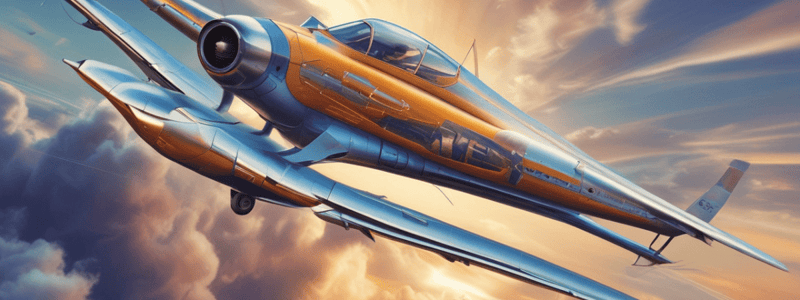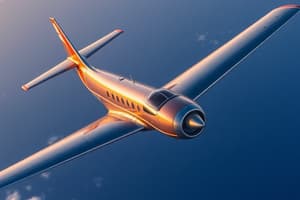Podcast
Questions and Answers
What is the primary goal in aircraft design in relation to drag?
What is the primary goal in aircraft design in relation to drag?
- Minimizing drag (correct)
- Increasing weight
- Minimizing lift
- Maximizing thrust
What is the force that enables an aircraft to ascend into the sky?
What is the force that enables an aircraft to ascend into the sky?
- Drag
- Lift (correct)
- Thrust
- Weight
What is the catalyst for flight that sets the stage for the other forces to engage?
What is the catalyst for flight that sets the stage for the other forces to engage?
- Weight
- Thrust (correct)
- Drag
- Lift
What is the force that pulls the aircraft towards the Earth?
What is the force that pulls the aircraft towards the Earth?
What is the result of the friction and pressure differences between the aircraft's surfaces and the surrounding air?
What is the result of the friction and pressure differences between the aircraft's surfaces and the surrounding air?
What is the purpose of the wings in generating lift?
What is the purpose of the wings in generating lift?
What contributes to the amount of lift produced?
What contributes to the amount of lift produced?
What must be overcome by lift for the aircraft to remain aloft?
What must be overcome by lift for the aircraft to remain aloft?
What are the four fundamental forces that act upon an aircraft in flight?
What are the four fundamental forces that act upon an aircraft in flight?
What is the opposing force that thrust must counteract?
What is the opposing force that thrust must counteract?
Aerodynamic forces are only theoretical concepts and have no practical application.
Aerodynamic forces are only theoretical concepts and have no practical application.
The shape of the wings is the only factor that contributes to the amount of lift produced.
The shape of the wings is the only factor that contributes to the amount of lift produced.
Thrust is the force that opposes the movement of an aircraft.
Thrust is the force that opposes the movement of an aircraft.
Lift is the force that pulls the aircraft towards the Earth.
Lift is the force that pulls the aircraft towards the Earth.
Drag is the force that enables an aircraft to ascend into the sky.
Drag is the force that enables an aircraft to ascend into the sky.
The four fundamental forces that act upon an aircraft in flight are thrust, drag, lift, and gravity.
The four fundamental forces that act upon an aircraft in flight are thrust, drag, lift, and gravity.
Aircraft design focuses on maximizing drag to improve performance.
Aircraft design focuses on maximizing drag to improve performance.
The angle of attack of the wings does not affect the amount of lift produced.
The angle of attack of the wings does not affect the amount of lift produced.
The force of weight is what propels an aircraft forward.
The force of weight is what propels an aircraft forward.
The primary function of the wings is to generate thrust.
The primary function of the wings is to generate thrust.
How do aerodynamic forces enable an aircraft to take flight, maneuver, and land safely?
How do aerodynamic forces enable an aircraft to take flight, maneuver, and land safely?
What is the relationship between thrust and drag in an aircraft in flight?
What is the relationship between thrust and drag in an aircraft in flight?
How does the shape of the wings contribute to the generation of lift?
How does the shape of the wings contribute to the generation of lift?
What are the factors that affect the amount of lift produced by an aircraft's wings?
What are the factors that affect the amount of lift produced by an aircraft's wings?
Why is it important to understand the interplay of aerodynamic forces in aircraft design?
Why is it important to understand the interplay of aerodynamic forces in aircraft design?
What is the role of weight in an aircraft in flight?
What is the role of weight in an aircraft in flight?
How does an aircraft's airspeed affect its ability to generate lift?
How does an aircraft's airspeed affect its ability to generate lift?
What is the significance of minimizing drag in aircraft design?
What is the significance of minimizing drag in aircraft design?
How do the four fundamental forces of aerodynamics work together to enable flight?
How do the four fundamental forces of aerodynamics work together to enable flight?
Why is lift considered the most magical of the aerodynamic forces?
Why is lift considered the most magical of the aerodynamic forces?
Study Notes
Principles of Aerodynamics
- The four fundamental aerodynamic forces: thrust, drag, lift, and weight
- Understanding these forces is crucial for safe and efficient flight
Thrust
- The force that propels an aircraft forward
- Typically generated by engines (jet turbines, propellers, or other propulsion systems)
- Counters the opposing force of drag
- The initial punch that lunges the airplane from the runway into the air
- Directed backwards, following Newton's third law of motion (every action has an equal and opposite reaction)
Drag
- The resistance an airplane faces as it slices through the air
- Caused by air molecules colliding with and slowing down the aircraft
- Form drag (frontal resistance) and induced drag (whirlpools of air trailing behind the wings)
- Pilots must understand both kinds to efficiently manage their aircraft's energy
Lift
- The force that enables an airplane to rise off the ground and stay aloft
- Generated by the wings, due to air flowing over the curved top surface
- Creates a lower pressure on top and a higher pressure beneath the wing, effectively sucking the wing upwards
- Magnitude depends on wing shape, size, and airspeed
Weight
- The force due to gravity acting on the mass of the aircraft
- Pulls the aircraft towards the Earth and must be overcome by lift for the aircraft to remain aloft
- Experienced as a constant downward force that pilots must counteract with the right amount of lift for a smooth flight
Interplay of Forces
- The balance of these forces is essential for safe and efficient flight
- Each force has its own vector, magnitude, and direction
- During different flight phases (takeoff, cruising, and landing), pilots continuously adjust controls to keep these forces in harmonious equilibrium
- Understanding the intricacies of these forces is not just academic, but essential for safe flight
Practical Applications
- Altering the speed or angle of attack significantly impacts lift and drag
- During landing, a speed reduction leads to decreased lift, necessitating a decrease in altitude
- Pilots must carefully manage this reduction to avoid insufficient lift and compromised safety
- Mastering these forces requires a mix of skill and technology, as well as responding to changing conditions of flight
Principles of Aerodynamics
- The four fundamental aerodynamic forces: thrust, drag, lift, and weight
- Understanding these forces is crucial for safe and efficient flight
Thrust
- The force that propels an aircraft forward
- Typically generated by engines (jet turbines, propellers, or other propulsion systems)
- Counters the opposing force of drag
- The initial punch that lunges the airplane from the runway into the air
- Directed backwards, following Newton's third law of motion (every action has an equal and opposite reaction)
Drag
- The resistance an airplane faces as it slices through the air
- Caused by air molecules colliding with and slowing down the aircraft
- Form drag (frontal resistance) and induced drag (whirlpools of air trailing behind the wings)
- Pilots must understand both kinds to efficiently manage their aircraft's energy
Lift
- The force that enables an airplane to rise off the ground and stay aloft
- Generated by the wings, due to air flowing over the curved top surface
- Creates a lower pressure on top and a higher pressure beneath the wing, effectively sucking the wing upwards
- Magnitude depends on wing shape, size, and airspeed
Weight
- The force due to gravity acting on the mass of the aircraft
- Pulls the aircraft towards the Earth and must be overcome by lift for the aircraft to remain aloft
- Experienced as a constant downward force that pilots must counteract with the right amount of lift for a smooth flight
Interplay of Forces
- The balance of these forces is essential for safe and efficient flight
- Each force has its own vector, magnitude, and direction
- During different flight phases (takeoff, cruising, and landing), pilots continuously adjust controls to keep these forces in harmonious equilibrium
- Understanding the intricacies of these forces is not just academic, but essential for safe flight
Practical Applications
- Altering the speed or angle of attack significantly impacts lift and drag
- During landing, a speed reduction leads to decreased lift, necessitating a decrease in altitude
- Pilots must carefully manage this reduction to avoid insufficient lift and compromised safety
- Mastering these forces requires a mix of skill and technology, as well as responding to changing conditions of flight
Principles of Aerodynamics
- The four fundamental aerodynamic forces: thrust, drag, lift, and weight
- Understanding these forces is crucial for safe and efficient flight
Thrust
- The force that propels an aircraft forward
- Typically generated by engines (jet turbines, propellers, or other propulsion systems)
- Counters the opposing force of drag
- The initial punch that lunges the airplane from the runway into the air
- Directed backwards, following Newton's third law of motion (every action has an equal and opposite reaction)
Drag
- The resistance an airplane faces as it slices through the air
- Caused by air molecules colliding with and slowing down the aircraft
- Form drag (frontal resistance) and induced drag (whirlpools of air trailing behind the wings)
- Pilots must understand both kinds to efficiently manage their aircraft's energy
Lift
- The force that enables an airplane to rise off the ground and stay aloft
- Generated by the wings, due to air flowing over the curved top surface
- Creates a lower pressure on top and a higher pressure beneath the wing, effectively sucking the wing upwards
- Magnitude depends on wing shape, size, and airspeed
Weight
- The force due to gravity acting on the mass of the aircraft
- Pulls the aircraft towards the Earth and must be overcome by lift for the aircraft to remain aloft
- Experienced as a constant downward force that pilots must counteract with the right amount of lift for a smooth flight
Interplay of Forces
- The balance of these forces is essential for safe and efficient flight
- Each force has its own vector, magnitude, and direction
- During different flight phases (takeoff, cruising, and landing), pilots continuously adjust controls to keep these forces in harmonious equilibrium
- Understanding the intricacies of these forces is not just academic, but essential for safe flight
Practical Applications
- Altering the speed or angle of attack significantly impacts lift and drag
- During landing, a speed reduction leads to decreased lift, necessitating a decrease in altitude
- Pilots must carefully manage this reduction to avoid insufficient lift and compromised safety
- Mastering these forces requires a mix of skill and technology, as well as responding to changing conditions of flight
Studying That Suits You
Use AI to generate personalized quizzes and flashcards to suit your learning preferences.
Related Documents
Description
Learn about the fundamental principles of aerodynamics and aircraft control systems. This course covers the basics of aerodynamics and how aircraft navigate through the air.




